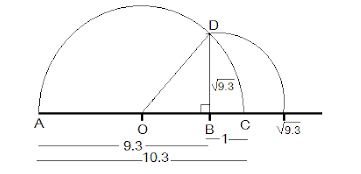NCERT Solutions for Class 9 Maths - Exercise 1.5 Number System
Q.1. Classify the following numbers as rational or irrational:
(i) 2 –√5
Solution:
We know that, √5 = 2.2360679…
Here, 2.2360679…is non-terminating and non-recurring.
Now, substituting the value of √5 in 2 –√5, we get,
2-√5 = 2-2.2360679… = -0.2360679
Since the number, – 0.2360679…, is non-terminating non-recurring, 2 –√5 is an irrational number.
(ii) (3 +√23)- √23
Solution:
(3 +√23) –√23 = 3+√23–√23
= 3
= 3/1
Since the number 3/1 is in p/q form, (3 +√23)- √23 is rational.
(iii) 2√7/7√7
Solution:
2√7/7√7 = ( 2/7)× (√7/√7)
We know that (√7/√7) = 1
Hence, ( 2/7)× (√7/√7) = (2/7)×1 = 2/7
Since the number, 2/7 is in p/q form, 2√7/7√7 is rational.
(iv) 1/√2
Solution:
Multiplying and dividing numerator and denominator by √2 we get,
(1/√2) ×(√2/√2)= √2/2 ( since √2×√2 = 2)
We know that, √2 = 1.4142…
Then, √2/2 = 1.4142/2 = 0.7071..
Since the number , 0.7071..is non-terminating non-recurring, 1/√2 is an irrational number.
(v) 2
Solution:
We know that, the value of = 3.1415
Hence, 2 = 2×3.1415.. = 6.2830…
Since the number, 6.2830…, is non-terminating non-recurring, 2 is an irrational number.
Q.2. Simplify each of the following expressions:
(i) (3+√3)(2+√2)
Solution:
(3+√3)(2+√2 )
Opening the brackets, we get, (3×2)+(3×√2)+(√3×2)+(√3×√2)
= 6+3√2+2√3+√6
(ii) (3+√3)(3-√3 )
Solution:
(3+√3)(3-√3 ) = 32-(√3)2 = 9-3
= 6
(iii) (√5+√2)2
Solution:
(√5+√2)2 = √52+(2×√5×√2)+ √22
= 5+2×√10+2 = 7+2√10
(iv) (√5-√2)(√5+√2)
Solution:
(√5-√2)(√5+√2) = (√52-√22) = 5-2 = 3
Q.3. Recall, π is defined as the ratio of the circumference (say c) of a circle to its diameter, (say d). That is, π = c/d. This seems to contradict the fact that π is irrational. How will you resolve this contradiction?
Solution:
There is no contradiction. When we measure a value with a scale, we only obtain an approximate value. We never obtain an exact value. Therefore, we may not realize whether c or d is irrational. The value of π is almost equal to 22/7 or 3.142857…
Q.4. Represent (√9.3) on the number line.
Solution:
Step 1: Draw a 9.3 units long line segment, AB. Extend AB to C such that BC = 1 unit.
Step 2: Now, AC = 10.3 units. Let the centre of AC be O.
Step 3: Draw a semi-circle of radius OC with centre O.
Step 4: Draw a BD perpendicular to AC at point B intersecting the semicircle at D. Join OD.
Step 5: OBD, obtained, is a right angled triangle.
Here, OD 10.3/2 (radius of semi-circle), OC = 10.3/2 , BC = 1
OB = OC – BC
⟹ (10.3/2)-1 = 8.3/2
Using Pythagoras theorem,
We get,
OD2 = BD2 + OB2
⟹ (10.3/2)2 = BD2+(8.3/2)2
⟹ BD2 = (10.3/2)2-(8.3/2)2
⟹ (BD)2 = (10.3/2)-(8.3/2)(10.3/2)+(8.3/2)
⟹ BD2 = 9.3
⟹ BD = √9.3
Thus, the length of BD is √9.3.
Step 6: Taking BD as radius and B as centre draw an arc which touches the line segment. The point where it touches the line segment is at a distance of √9.3 from O as shown in the figure.
Q.5. Rationalize the denominators of the following:
(i) 1/√7
Solution:
Multiply and divide 1/√7 by √7
(1×√7)/(√7×√7) = √7/7
(ii) 1/(√7-√6)
Solution:
Multiply and divide 1/(√7-√6) by (√7+√6)
[1/(√7-√6)]×(√7+√6)/(√7+√6) = (√7+√6)/(√7-√6)(√7+√6)
= (√7+√6)/√72-√62 [denominator is obtained by the property, (a+b)(a-b) = a2-b2]
= (√7+√6)/(7-6)
= (√7+√6)/1
= √7+√6
(iii) 1/(√5+√2)
Solution:
Multiply and divide 1/(√5+√2) by (√5-√2)
[1/(√5+√2)]×(√5-√2)/(√5-√2) = (√5-√2)/(√5+√2)(√5-√2)
= (√5-√2)/(√52-√22) [denominator is obtained by the property, (a+b)(a-b) = a2-b2]
= (√5-√2)/(5-2)
= (√5-√2)/3
(iv) 1/(√7-2)
Solution:
Multiply and divide 1/(√7-2) by (√7+2)
1/(√7 - 2)×(√7 + 2)/(√7 + 2) = (√7 + 2)/(√7 - 2)(√7 + 2)
= (√7 + 2)/(√72 - 22) [denominator is obtained by the property, (a + b)(a - b) = a2-b2]
= (√7 + 2)/(7 - 4)
= (√7 + 2)/3
|
1 videos|228 docs|21 tests
|
FAQs on NCERT Solutions for Class 9 Maths - Exercise 1.5 Number System
| 1. What are the NCERT Solutions for Exercise 1.5 in the Number System Class 9? |  |
| 2. Where can I find the NCERT Solutions for Exercise 1.5 in the Number System Class 9? |  |
| 3. How can NCERT Solutions for Exercise 1.5 in the Number System Class 9 help me in my exam preparation? |  |
| 4. Are the NCERT Solutions for Exercise 1.5 in the Number System Class 9 available in multiple languages? |  |
| 5. Can I rely solely on the NCERT Solutions for Exercise 1.5 in the Number System Class 9 for my exam preparation? |  |

|
Explore Courses for Class 9 exam
|

|


















